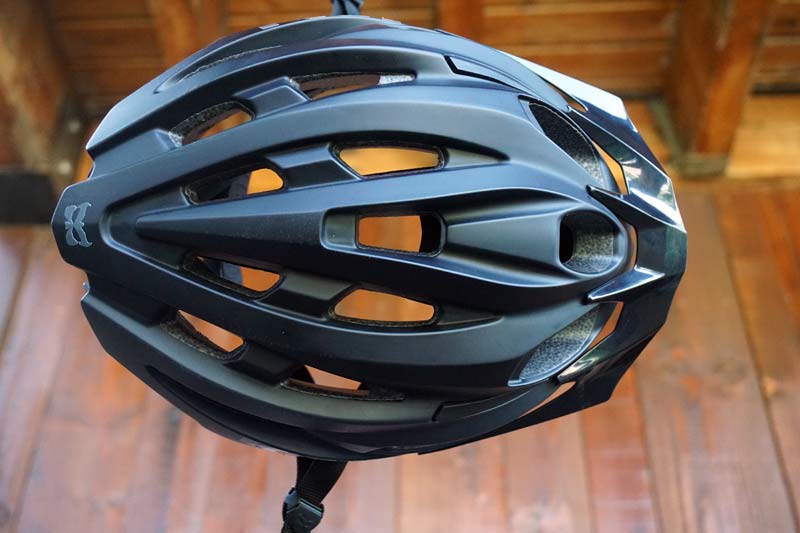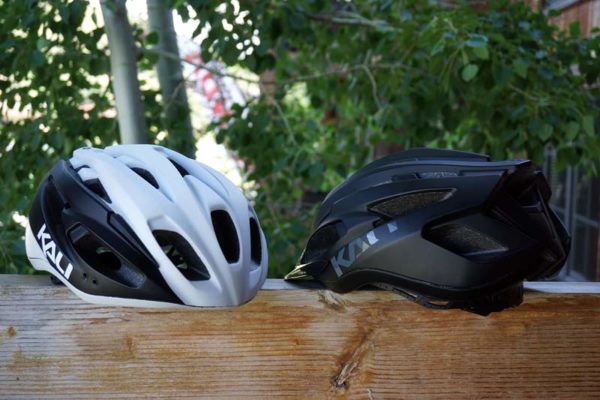Kali’s big on safety. They like to say, if you’re going to crash, you want to crash in their helmets. They take data from some of the biggest crashes (like Nicholi Rogatkin’s 2015 Red Bull Rampage crash) and recreate those forces in the lab. With that, they’ve developed things like Armourgel, low density foam, and multi-impact foams. Like any brand, these products first appear on top end products. What Kali does particularly well, besides pushing new safety tech, is bringing that tech down to lower price points quickly. The Lunati is a great example of that, with dual density foam at $80. And they’re pushing the Armourgel into all of their helmets by 2019. Why? Because as they say, safety should be a standard, not an upgrade.
For now, they’re offering two new helmets with it, the Alchemy and Therapy. Both are $100 and use the same shape, but the Alchemy adds a visor for mountain biking. Check ’em out…
The only difference between the Alchemy (mountain bike) and Therapy (road) is the visor. The body, shell and all details are identical, including the 21 vents, locking strap sliders and Micro-Fit closure system on the rear retention cradle.
The front vents are gaping to let a lot of air in. The styling is similar to their Maraka helmet, which was one of their first bicycle helmets and still one of their best sellers (and one of our favorites).
Providing the safety is their Composite Fusion EPS construction, which pairs a low density foam with a standard one to create more cushion during impact and better control the rate of brain movement by slowing down the initial hit more than the harder standard EPS required to pass certifications. Rather than use MIPS, Kali’s founder Brad has been working with ArmourGel to create their own anti-rotation solution. Made of soft, pliable rubbery nubs on strips places all around the head, these flex to allow the helmet to rotate a small amount prior to the head rotating. It’s minimal, but in their testing, it provides equal or better protection with less weight.
It also keeps all of the vents fully open since there’s no sleeve or shell inside the helmet. Retail is $100 for either model, and they should be available soon. Final production weight TBD.
Across the rest of their range, you can expect some new colors and patterns coming through the rest of the year…
…like this killer gray-on-black matte option for the Maraka.
Kali had some pretty standard knee and elbow pads in the past, but now there’s a renewed push on their end to make something lighter and more flexible. These prototypes should move into a product version soon and use an impact sensitive material on the kneecap and upper shin that hardens on impact to disperse the forces, but is otherwise very soft to move with you while pedaling. The back has a mesh panel to breathe, and production versions will get a small Velcro tab at the top to help them stay up.
The new Venture Gloves add more padding than their original gloves, and add TPR bumper protection on the outside edge of the hand and fingers. A simple Velcro strap secures them, and you’ll want to err on the side of ordering too big. The XL fit me snug, but they say the microfiber palm (feels like synthetic leather) should stretch a bit with use.
The knuckles are gusseted to flex with you, and the palm padding runs only across the lower section where your weight is usually resting. It, too, is shaped to flex, which should prevent any bunching up and help you maintain good bar feel. Silicone graphics on the palm and fingers enhance grip. Retail is $40, available soon.











